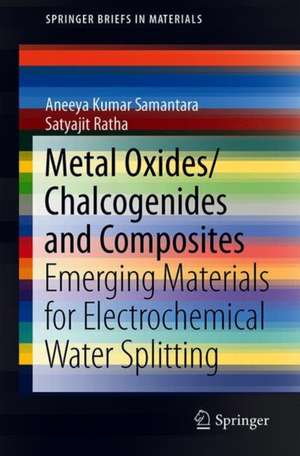Metal Oxides/Chalcogenides and Composites: Emerging Materials for Electrochemical Water Splitting: SpringerBriefs in Materials
Autor Aneeya Kumar Samantara, Satyajit Rathaen Limba Engleză Paperback – 24 aug 2019
This book covers the recent development of metal oxides, hydroxides and their carbon composites for electrochemical oxidation of water in the production of hydrogen and oxygen as fuels. It includes a detailed discussion on synthesis methodologies for the metal oxides/hydroxides, structural/morphological characterizations, and the key parameters (Tafel plot, Turnover frequency, Faradic efficiency, overpotential, long cycle life etc.) needed to evaluate the electrocatalytic activity of the materials. Additionally, the mechanism behind the electro oxidation process is presented. Readers will find a comprehensive source on the close correlation between metal oxides, hydroxides, composites, and their properties and importance in the generation of hydrogen and oxygen from water.
Din seria SpringerBriefs in Materials
-
 Preț: 315.57 lei
Preț: 315.57 lei -
 Preț: 346.86 lei
Preț: 346.86 lei -
 Preț: 343.98 lei
Preț: 343.98 lei -
 Preț: 344.90 lei
Preț: 344.90 lei -
 Preț: 357.97 lei
Preț: 357.97 lei -
 Preț: 344.90 lei
Preț: 344.90 lei -
 Preț: 344.90 lei
Preț: 344.90 lei -
 Preț: 394.83 lei
Preț: 394.83 lei -
 Preț: 377.18 lei
Preț: 377.18 lei -
 Preț: 375.23 lei
Preț: 375.23 lei -
 Preț: 380.63 lei
Preț: 380.63 lei -
 Preț: 374.46 lei
Preț: 374.46 lei -
 Preț: 378.92 lei
Preț: 378.92 lei -
 Preț: 378.92 lei
Preț: 378.92 lei -
 Preț: 380.07 lei
Preț: 380.07 lei -
 Preț: 377.18 lei
Preț: 377.18 lei -
 Preț: 343.98 lei
Preț: 343.98 lei -
 Preț: 344.21 lei
Preț: 344.21 lei -
 Preț: 377.18 lei
Preț: 377.18 lei -
 Preț: 376.22 lei
Preț: 376.22 lei -
 Preț: 374.85 lei
Preț: 374.85 lei -
 Preț: 412.30 lei
Preț: 412.30 lei -
 Preț: 376.22 lei
Preț: 376.22 lei -
 Preț: 374.08 lei
Preț: 374.08 lei -
 Preț: 445.88 lei
Preț: 445.88 lei -
 Preț: 376.80 lei
Preț: 376.80 lei -
 Preț: 385.47 lei
Preț: 385.47 lei -
 Preț: 377.35 lei
Preț: 377.35 lei -
 Preț: 377.18 lei
Preț: 377.18 lei -
 Preț: 375.45 lei
Preț: 375.45 lei -
 Preț: 377.35 lei
Preț: 377.35 lei -
 Preț: 377.73 lei
Preț: 377.73 lei -
 Preț: 380.07 lei
Preț: 380.07 lei -
 Preț: 380.07 lei
Preț: 380.07 lei -
 Preț: 378.71 lei
Preț: 378.71 lei -
 Preț: 412.30 lei
Preț: 412.30 lei -
 Preț: 380.07 lei
Preț: 380.07 lei -
 Preț: 377.18 lei
Preț: 377.18 lei -
 Preț: 378.71 lei
Preț: 378.71 lei -
 Preț: 377.57 lei
Preț: 377.57 lei -
 Preț: 377.18 lei
Preț: 377.18 lei -
 Preț: 442.24 lei
Preț: 442.24 lei -
 Preț: 378.34 lei
Preț: 378.34 lei -
 Preț: 381.00 lei
Preț: 381.00 lei -
 Preț: 373.32 lei
Preț: 373.32 lei -
 Preț: 376.22 lei
Preț: 376.22 lei -
 Preț: 377.95 lei
Preț: 377.95 lei -
 Preț: 376.80 lei
Preț: 376.80 lei -
 Preț: 376.04 lei
Preț: 376.04 lei
Preț: 377.18 lei
Nou
Puncte Express: 566
Preț estimativ în valută:
72.18€ • 75.08$ • 59.59£
72.18€ • 75.08$ • 59.59£
Carte tipărită la comandă
Livrare economică 14-28 aprilie
Preluare comenzi: 021 569.72.76
Specificații
ISBN-13: 9783030248604
ISBN-10: 3030248607
Pagini: 86
Ilustrații: XVII, 83 p. 23 illus. in color.
Dimensiuni: 155 x 235 mm
Greutate: 0.16 kg
Ediția:1st ed. 2019
Editura: Springer International Publishing
Colecția Springer
Seria SpringerBriefs in Materials
Locul publicării:Cham, Switzerland
ISBN-10: 3030248607
Pagini: 86
Ilustrații: XVII, 83 p. 23 illus. in color.
Dimensiuni: 155 x 235 mm
Greutate: 0.16 kg
Ediția:1st ed. 2019
Editura: Springer International Publishing
Colecția Springer
Seria SpringerBriefs in Materials
Locul publicării:Cham, Switzerland
Cuprins
Chapter1: Introduction.- Chapter2: Types of Electrolysis of Water.- Chapter3: Mechanism and key parameters for catalyst evaluation.- Chapter4: Electroactive Materials.- Chapter5: Potential Applications of Electrolysis for Commercial Hydrogen Production.- Chapter6: Summary and Conclusion
Notă biografică
Dr. Aneeya Kumar Samantara is presently working as a post-doctoral fellow at School of Chemical Sciences, National Institute of Science Education and Research, Khordha, Odisha, India. He has pursued his PhD. at CSIR-Institute of Minerals and Materials Technology, Bhubaneswar, Odisha, India. Before joining the PhD. program, he completed the Master of philosophy (M.Phil.) in chemistry from Utkal University and Master in Science in Advanced Organic Chemistry at Ravenshaw University, Cuttack, Odisha. Aneeya’s research interests include the synthesis of metal oxide/chalcogenides and graphene composites for energy storage and conversion applications. To his credit, he has authored or co-authored 21 (twenty one) peer-reviewed international journal articles, six books (two books for Springer, two for Arcler Press and two in Global Publishing house, India) and four book chapters. Four books and two research journals are in press and are expected to publish soon.
Dr. Satyajit Ratha has pursued his PhD at the School of Basic Sciences, Indian Institute of Technology, Bhubaneswar, India. Prior to joining IIT Bhubaneswar, he received his Bachelor of Science, First Class Honours from Utkal University, in 2008 and Master of Science from Ravenshaw University in 2010. Satyajit’s research interests include two dimensional semiconductors, nanostructure synthesis, applications, energy storage devices and supercapacitors. He has authored or co-authored about 20 articles in peer-reviewed, international journals, two books for Springer and two for Arcler Press.
Dr. Satyajit Ratha has pursued his PhD at the School of Basic Sciences, Indian Institute of Technology, Bhubaneswar, India. Prior to joining IIT Bhubaneswar, he received his Bachelor of Science, First Class Honours from Utkal University, in 2008 and Master of Science from Ravenshaw University in 2010. Satyajit’s research interests include two dimensional semiconductors, nanostructure synthesis, applications, energy storage devices and supercapacitors. He has authored or co-authored about 20 articles in peer-reviewed, international journals, two books for Springer and two for Arcler Press.
Caracteristici
Provides an overview of the synthesis of metal oxides and their composite nanomaterials for use as electrocatalysts Includes the key parameters for the performance evaluation of metal oxides Presents a mechanistic discussion on the electrochemical oxidation of water Explores new aspects of materials synthesis, composite preparation and characterization
